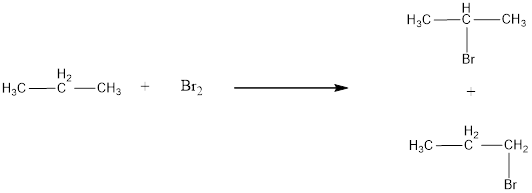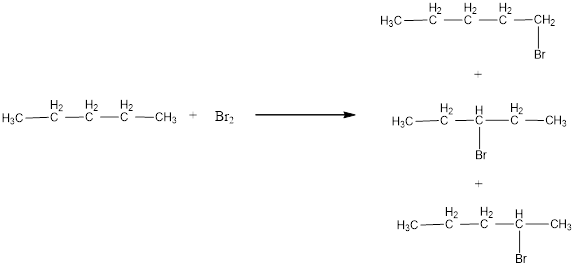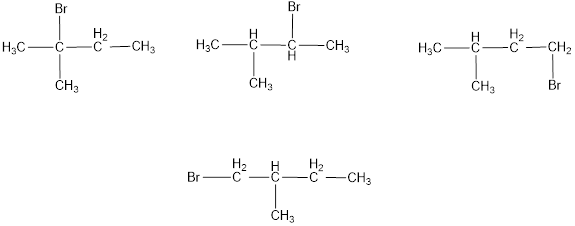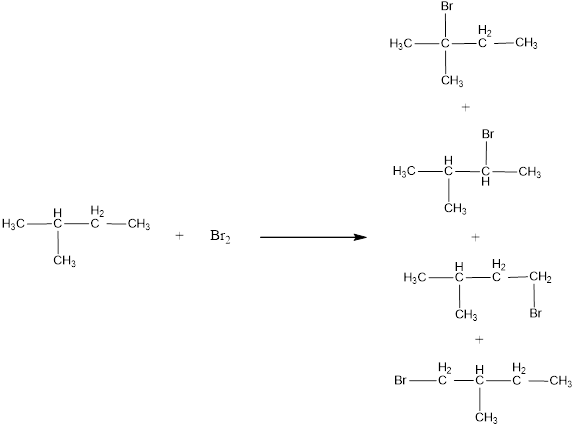
Concept explainers
(a)
Interpretation:
Structural formula for all the possible monobrominated products obtained from halogenation of propane has to be written.
Concept Introduction:
Alkanes are not completely inert. Two important reactions that alkanes undergo are combustion and halogenation.
Combustion reaction is the one where reaction occurs between substance and oxygen which proceeds with evolution of light and heat. Due to the heat produced when alkanes are made to undergo combustion with oxygen, it is used as fuel.
Halogenation is a
Halogenation reaction of alkane is an example of substitution reaction. This is a reaction where a part of reacting molecule replaces an atom or group of atoms in hydrocarbon or hydrocarbon derivative.
Cycloalkanes are also similar to those of alkanes. Cycloalkanes also undergo combustion and halogenation reaction.
(a)
Answer to Problem 1.134EP
The monobrominated products of propane are,

Explanation of Solution
Halogenation is a chemical reaction between a substance and halogen. The product of halogenation reaction is that one or more halogens are incorporated into molecules of the substance. Halogenation of hydrocarbon gives hydrocarbon derivatives as product where halogen atoms are substituted instead of hydrogen atoms.
Halogenation reaction of alkane is an example of substitution reaction. This is a reaction where a part of reacting molecule replaces an atom or group of atoms in hydrocarbon or hydrocarbon derivative.
General reaction for halogenation of alkane can be given as shown below,
The halogenation reaction takes place giving a mixture of products where the hydrogen atoms present in the alkane are substituted randomly.
Given alkane is propane. Two kinds of hydrogen is present in propane. Therefore, bromination of propane will lead to two monobrominated product as shown below,

The structural formula for monobrominated product of propane was drawn.
(b)
Interpretation:
Structural formula for all the possible monobrominated products obtained from halogenation of pentane has to be written.
Concept Introduction:
Alkanes are linear chain saturated hydrocarbons. The reactivity of alkanes are very less. They can be heated for a very long time in strong acids and bases without any reaction. Even strong reducing and strong oxidizing agents have less effect on alkanes.
Alkanes are not completely inert. Two important reactions that alkanes undergo are combustion and halogenation.
Combustion reaction is the one where reaction occurs between substance and oxygen which proceeds with evolution of light and heat. Due to the heat produced when alkanes are made to undergo combustion with oxygen, it is used as fuel.
Halogenation is a chemical reaction between a substance and halogen. The product of halogenation reaction is that one or more halogens are incorporated into molecules of the substance. Halogenation of hydrocarbon gives hydrocarbon derivatives as product where halogen atoms are substituted instead of hydrogen atoms.
Halogenation reaction of alkane is an example of substitution reaction. This is a reaction where a part of reacting molecule replaces an atom or group of atoms in hydrocarbon or hydrocarbon derivative.
Cycloalkanes are also similar to those of alkanes. Cycloalkanes also undergo combustion and halogenation reaction.
(b)
Answer to Problem 1.134EP
The monobrominated products of pentane are,

Explanation of Solution
Halogenation is a chemical reaction between a substance and halogen. The product of halogenation reaction is that one or more halogens are incorporated into molecules of the substance. Halogenation of hydrocarbon gives hydrocarbon derivatives as product where halogen atoms are substituted instead of hydrogen atoms.
Halogenation reaction of alkane is an example of substitution reaction. This is a reaction where a part of reacting molecule replaces an atom or group of atoms in hydrocarbon or hydrocarbon derivative.
General reaction for halogenation of alkane can be given as shown below,
The halogenation reaction takes place giving a mixture of products where the hydrogen atoms present in the alkane are substituted randomly.
Given alkane is pentane. Three kinds of hydrogen atoms are present in pentane. Therefore, bromination of pentane will lead to three monobrominated product as shown below,

The structural formula for monobrominated products of pentane was drawn.
(c)
Interpretation:
Structural formula for all the possible monobrominated products obtained from halogenation of 2-methylbutane has to be written.
Concept Introduction:
Alkanes are linear chain saturated hydrocarbons. The reactivity of alkanes are very less. They can be heated for a very long time in strong acids and bases without any reaction. Even strong reducing and strong oxidizing agents have less effect on alkanes.
Alkanes are not completely inert. Two important reactions that alkanes undergo are combustion and halogenation.
Combustion reaction is the one where reaction occurs between substance and oxygen which proceeds with evolution of light and heat. Due to the heat produced when alkanes are made to undergo combustion with oxygen, it is used as fuel.
Halogenation is a chemical reaction between a substance and halogen. The product of halogenation reaction is that one or more halogens are incorporated into molecules of the substance. Halogenation of hydrocarbon gives hydrocarbon derivatives as product where halogen atoms are substituted instead of hydrogen atoms.
Halogenation reaction of alkane is an example of substitution reaction. This is a reaction where a part of reacting molecule replaces an atom or group of atoms in hydrocarbon or hydrocarbon derivative.
Cycloalkanes are also similar to those of alkanes. Cycloalkanes also undergo combustion and halogenation reaction.
(c)
Answer to Problem 1.134EP
The monobrominated products of 2-methylbutane are,

Explanation of Solution
Halogenation is a chemical reaction between a substance and halogen. The product of halogenation reaction is that one or more halogens are incorporated into molecules of the substance. Halogenation of hydrocarbon gives hydrocarbon derivatives as product where halogen atoms are substituted instead of hydrogen atoms.
Halogenation reaction of alkane is an example of substitution reaction. This is a reaction where a part of reacting molecule replaces an atom or group of atoms in hydrocarbon or hydrocarbon derivative.
General reaction for halogenation of alkane can be given as shown below,
The halogenation reaction takes place giving a mixture of products where the hydrogen atoms present in the alkane are substituted randomly.
Given alkane is 2-methylbutane. Four kinds of hydrogen atoms are present in 2-methylbutane. Therefore, bromination of 2-methylbutane will lead to four monobrominated product as shown below,

The structural formula for monobrominated products of 2-methylbutane was drawn.
(d)
Interpretation:
Structural formula for all the possible monobrominated products obtained from halogenation of cyclohexane has to be written.
Concept Introduction:
Alkanes are linear chain saturated hydrocarbons. The reactivity of alkanes are very less. They can be heated for a very long time in strong acids and bases without any reaction. Even strong reducing and strong oxidizing agents have less effect on alkanes.
Alkanes are not completely inert. Two important reactions that alkanes undergo are combustion and halogenation.
Combustion reaction is the one where reaction occurs between substance and oxygen which proceeds with evolution of light and heat. Due to the heat produced when alkanes are made to undergo combustion with oxygen, it is used as fuel.
Halogenation is a chemical reaction between a substance and halogen. The product of halogenation reaction is that one or more halogens are incorporated into molecules of the substance. Halogenation of hydrocarbon gives hydrocarbon derivatives as product where halogen atoms are substituted instead of hydrogen atoms.
Halogenation reaction of alkane is an example of substitution reaction. This is a reaction where a part of reacting molecule replaces an atom or group of atoms in hydrocarbon or hydrocarbon derivative.
Cycloalkanes are also similar to those of alkanes. Cycloalkanes also undergo combustion and halogenation reaction.
(d)
Answer to Problem 1.134EP
The monobrominated products of cyclohexane is,

Explanation of Solution
Halogenation is a chemical reaction between a substance and halogen. The product of halogenation reaction is that one or more halogens are incorporated into molecules of the substance. Halogenation of hydrocarbon gives hydrocarbon derivatives as product where halogen atoms are substituted instead of hydrogen atoms.
Halogenation reaction of alkane is an example of substitution reaction. This is a reaction where a part of reacting molecule replaces an atom or group of atoms in hydrocarbon or hydrocarbon derivative.
General reaction for halogenation of alkane can be given as shown below,
The halogenation reaction takes place giving a mixture of products where the hydrogen atoms present in the alkane are substituted randomly.
Given cycloalkane is cyclohexane. Only one kind of hydrogen is present in cyclohexane. Therefore, bromination of cyclohexane will lead to the same monobrominated product as shown below,

The structural formula for monobrominated product of cyclohexane was drawn.
Want to see more full solutions like this?
Chapter 1 Solutions
Organic And Biological Chemistry
- Write structural formulas for all the possible halogenated hydrocarbon products from the monobromination of the following alkanes or cycloalkanes. a. Propane b. Pentane c. 2-Methylbutane d. Cyclohexanearrow_forwardWhat property is characteristic of chlorinated hydrocarbons? a. chemical stability b. high flammability c. high chemical reactivityarrow_forwardAlcohols are very useful starting materials for the production of many different compounds. The following conversions, starting with 1-butanol, can be carried out in two or more steps. Show the steps (reactants/catalysts) you would follow to carry out the conversions, drawing the formula for the organic product in each step. For each step, a major product must be produced. (See Exercise 62.) (Hint: In the presence of H+, an alcohol is converted into an alkene and water. This is the exact reverse of the reaction of adding water to an alkene to form an alcohol.) a. 1-butanol butane b. 1-butanol 2-butanonearrow_forward
 General, Organic, and Biological ChemistryChemistryISBN:9781285853918Author:H. Stephen StokerPublisher:Cengage Learning
General, Organic, and Biological ChemistryChemistryISBN:9781285853918Author:H. Stephen StokerPublisher:Cengage Learning Organic And Biological ChemistryChemistryISBN:9781305081079Author:STOKER, H. Stephen (howard Stephen)Publisher:Cengage Learning,Chemistry: Matter and ChangeChemistryISBN:9780078746376Author:Dinah Zike, Laurel Dingrando, Nicholas Hainen, Cheryl WistromPublisher:Glencoe/McGraw-Hill School Pub Co
Organic And Biological ChemistryChemistryISBN:9781305081079Author:STOKER, H. Stephen (howard Stephen)Publisher:Cengage Learning,Chemistry: Matter and ChangeChemistryISBN:9780078746376Author:Dinah Zike, Laurel Dingrando, Nicholas Hainen, Cheryl WistromPublisher:Glencoe/McGraw-Hill School Pub Co Chemistry: The Molecular ScienceChemistryISBN:9781285199047Author:John W. Moore, Conrad L. StanitskiPublisher:Cengage Learning
Chemistry: The Molecular ScienceChemistryISBN:9781285199047Author:John W. Moore, Conrad L. StanitskiPublisher:Cengage Learning Chemistry: Principles and PracticeChemistryISBN:9780534420123Author:Daniel L. Reger, Scott R. Goode, David W. Ball, Edward MercerPublisher:Cengage Learning
Chemistry: Principles and PracticeChemistryISBN:9780534420123Author:Daniel L. Reger, Scott R. Goode, David W. Ball, Edward MercerPublisher:Cengage Learning





